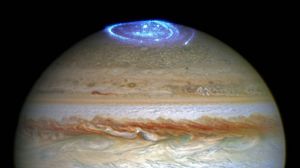The most powerful telescope in space has turned its sights to the largest planet in the solar system, revealing a dazzling new perspective of a world that has captivated humans for thousands of years.
With its swirling gas clouds and radiant auroras, Jupiter is a particularly photogenic target for both amateur skywatchers and professional astronomers. Now, the James Webb Space Telescope (JWST), the most sensitive observatory in space, has captured extraordinary infrared images of the planet, which reveal its swirling gas clouds, brilliant auroras, and intricate ring system in exquisite detail.
Videos by VICE
The resolution of the pictures is so high that distant galaxies can be seen in the background “photobombing” Jupiter, according to a NASA statement released on Monday.
“We hadn’t really expected it to be this good, to be honest,” said Imke de Pater, professor emerita of the University of California, Berkeley who co-led JWST’s Jupiter observations, in the statement. “It’s really remarkable that we can see details on Jupiter together with its rings, tiny satellites, and even galaxies in one image.”
JWST, which was launched in December, is a collaborative project between NASA, the European Space Agency, and the Canadian Space Agency. With 100 times the observational power of the Hubble Space Telescope, the new observatory can peer into the distant universe, but it is also changing our view of vistas much closer to home.
Its new images of Jupiter, for instance, were captured in infrared light by JWST’s Near-Infrared Camera (NIRCam), which is why this massive gas giant appears more eerily spectral than previous optical images that burst with color. Because humans cannot see infrared light, these composite shots have been adjusted by citizen scientist Judy Schmidt into a visible-light palette, with brighter spots generally indicating regions at higher altitudes.
Jupiter’s energetic auroras, which are still not entirely understood, are seen glowing at the poles of the massive planet. A wider shot of the gas giant includes its so-called “dark ring system,” which is mostly made up of faint dust particles, as well as two small Jovian moons called Amalthea and Adrastea.
The gorgeous shots of Jupiter are just the latest in a deluge of new and exciting observations from JWST, which released its first pictures in July. Though the telescope team is still in the process of calibrating and perfecting its abilities, the complex mission is already exceeding expectations and changing our understanding of the universe on both local and cosmic scales.





